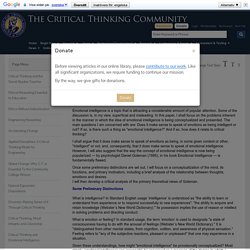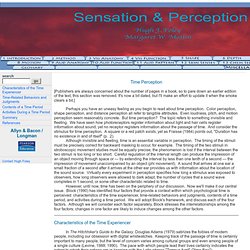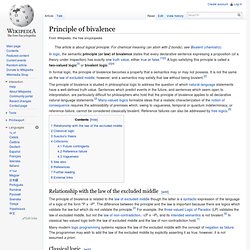

Why do humans reason. "Discovery" Lucid Dream Induction + Binaural Beats (90 Min Cycle)
Mental imagery influences our perception. Basics - Abstract Thoughts Prompt Literal Physical Responses. Prisoner's dilemma. The prisoners' dilemma is a canonical example of a game analyzed in game theory that shows why two individuals might not cooperate, even if it appears that it is in their best interests to do so. It was originally framed by Merrill Flood and Melvin Dresher working at RAND in 1950.
Albert W. Tucker formalized the game with prison sentence rewards and gave it the name "prisoner's dilemma" (Poundstone, 1992), presenting it as follows: Two members of a criminal gang are arrested and imprisoned. Each prisoner is in solitary confinement with no means of speaking to or exchanging messages with the other. It's implied that the prisoners will have no opportunity to reward or punish their partner other than the prison sentences they get, and that their decision won't affect their reputation in future. The prisoner's dilemma game can be used as a model for many real world situations involving cooperative behaviour. Strategy for the classic prisoners' dilemma[edit] The normal game is shown below: Game theory. Game theory is the study of strategic decision making.

Specifically, it is "the study of mathematical models of conflict and cooperation between intelligent rational decision-makers. "[1] An alternative term suggested "as a more descriptive name for the discipline" is interactive decision theory.[2] Game theory is mainly used in economics, political science, and psychology, as well as logic, computer science, and biology. The subject first addressed zero-sum games, such that one person's gains exactly equal net losses of the other participant or participants. Theremin. Noesis. Critical Thinking and Emotional Intelligence. In addition to Goleman’s lack of sensitivity to the brain-to-mind translation problem, and his failure to acknowledge that we already know much about the mind through its works and constructs, Goleman’s work is often inconsistent and sometimes incoherent.

Let us look at some cases. Two Brains Equals Two Minds Because Goleman’s “theory” of mind is based strictly on his interpretations of data from brain research, he comes to some questionable conclusions about the mind. For example, he states, “sensory signals from eye or ear travel first in the brain to the thalamus and then — across a single synapse — to the amygdala; a second signal from the thalamus is routed to the neocortex — the thinking brain. This branching allows the amygdala to begin to respond before the neocortex, which mulls information through several levels of brain circuits before it fully perceives and finally initiates its more finely tailored response (p. 17).” UC Berkeley Press Release. By Yasmin Anwar, Media Relations | 08 December 2009 BERKELEY — Researchers at the University of California, Berkeley, are challenging long-held beliefs that human beings are wired to be selfish.

In a wide range of studies, social scientists are amassing a growing body of evidence to show we are evolving to become more compassionate and collaborative in our quest to survive and thrive. (Photo illustration by Jonathan Payne) In contrast to "every man for himself" interpretations of Charles Darwin's theory of evolution by natural selection, Dacher Keltner, a UC Berkeley psychologist and author of "Born to be Good: The Science of a Meaningful Life," and his fellow social scientists are building the case that humans are successful as a species precisely because of our nurturing, altruistic and compassionate traits. Time Perception. Time Perception [Publishers are always concerned about the number of pages in a book, so to pare down an earlier edition of the text, this section was removed.

It's now a bit dated, but I'll make an effort to update it when the smoke clears a bit.] Perhaps you have an uneasy feeling as you begin to read about time perception. Color perception, shape perception, and distance perception all refer to tangible attributes. HOW DOES OUR LANGUAGE SHAPE THE WAY WE THINK? By Lera Boroditsky. Humans communicate with one another using a dazzling array of languages, each differing from the next in innumerable ways.

Do the languages we speak shape the way we see the world, the way we think, and the way we live our lives? Do people who speak different languages think differently simply because they speak different languages? Does learning new languages change the way you think? Ragnarök. The north portal of the 11th century Urnes stave church has been interpreted as containing depictions of snakes and dragons that represent Ragnarök In Norse mythology, Ragnarök is a series of future events, including a great battle foretold to ultimately result in the death of a number of major figures (including the gods Odin, Thor, Týr, Freyr, Heimdallr, and Loki), the occurrence of various natural disasters, and the subsequent submersion of the world in water.

Afterward, the world will resurface anew and fertile, the surviving and returning gods will meet, and the world will be repopulated by two human survivors. Ragnarök is an important event in the Norse canon, and has been the subject of scholarly discourse and theory. The event is attested primarily in the Poetic Edda, compiled in the 13th century from earlier traditional sources, and the Prose Edda, written in the 13th century by Snorri Sturluson. Mythology[edit] Wpływ muzyki na programowanie ludzi - Prawda2. Idea Seeding Better Than Brainstorming. Kevin Cheng and Tom Chi, at OK/Cancel have written an article sharing the creative process they use for creating their awesome strips.

Idea seeding is the process where they use time constraints and design/refine cycles to improve their ability to create quality “product.” They also wonder about extending this approach to other areas where brainstorming is normally used. OK/Cancel Even if you aren’t interested in idea seeding, you need to check out OK/Cancel. Tom and Kevin are incredibly talented designers who run a popular website creating a great community focused on (software) interfaces and the people who create them.
A recent favorite strip of mine shows whatmight be titled Project Managers Behaving Badly. Brainstorming Out Kevin details their old design process for creating new strips, which involved a 2 to 4 hour brainstorming session. Idea Seeding In. Anima and animus. The anima and animus can be identified as the totality of the unconscious feminine psychological qualities that a male possesses or the masculine ones possessed by the female, respectively.

It is an archetype of the collective unconscious and not an aggregate of father or mother, brothers, sisters, aunts, uncles or teachers, though these aspects of the personal unconscious can influence the person for good or ill. In the book The Invisible Partners it is said that the key to controlling one's anima/animus is to recognize it when it manifests and exercise our ability to discern the anima/animus from reality.[2] Levels of anima development[edit] Eve[edit] The first is Eve, named after the Genesis account of Adam and Eve. Helen[edit] Everything you ever wanted to know about anarchism. This classic statement of anarchism was written by a diverse group of anarchists in Cardiff around 1980 and it is an interesting historical record of the optimism of mainstream anarchist thought at that time.

There is probably more rubbish talked about anarchism than any other political idea. Actually, it has nothing to do with a belief in chaos, death and destruction. Principle of bivalence. In formal logic, the principle of bivalence becomes a property that a semantics may or may not possess.

It is not the same as the law of excluded middle, however, and a semantics may satisfy that law without being bivalent.[2] The principle of bivalence is studied in philosophical logic to address the question of which natural-language statements have a well-defined truth value. Cognitive dissonance. In psychology, cognitive dissonance is the mental stress or discomfort experienced by an individual who holds two or more contradictory beliefs, ideas, or values at the same time, or is confronted by new information that conflicts with existing beliefs, ideas, or values.[1][2] Leon Festinger's theory of cognitive dissonance focuses on how humans strive for internal consistency.
When inconsistency (dissonance) is experienced, individuals tend to become psychologically uncomfortable and they are motivated to attempt to reduce this dissonance, as well as actively avoiding situations and information which are likely to increase it.[1] Relationship between cognitions[edit] Individuals can adjust their attitudes or actions in various ways. Adjustments result in one of three relationships between two cognitions or between a cognition and a behavior.[1] Magnitude of dissonance[edit] The pressure to reduce cognitive dissonance is a function of the magnitude of said dissonance.[1] Reducing[edit] Tarski Prawda i dowod.pdf. Analiza transakcyjna. Many-valued logic.
In logic, a many-valued logic (also multi- or multiple-valued logic) is a propositional calculus in which there are more than two truth values. Traditionally, in Aristotle's logical calculus, there were only two possible values (i.e., "true" and "false") for any proposition. An obvious extension to classical two-valued logic is an n-valued logic for n greater than 2. Those most popular in the literature are three-valued (e.g., Łukasiewicz's and Kleene's, which accept the values "true", "false", and "unknown"), the finite-valued with more than three values, and the infinite-valued, such as fuzzy logic and probability logic.
History[edit] The first known classical logician who didn't fully accept the law of excluded middle was Aristotle (who, ironically, is also generally considered to be the first classical logician and the "father of logic"[1]). The 20th century brought back the idea of multi-valued logic. Examples[edit] Kleene (strong) K3 and Priest logic P3[edit] Belnap logic (B4)[edit] Philosophy since the Enlightenment, by Roger Jones - StumbleUpon. Linearność - Nielinearność < Teoria < Hipertest < Techsty - Literatura i nowe media. Dunning–Kruger effect.
Cognitive bias about one's own skill The Dunning–Kruger effect is a hypothetical cognitive bias stating that people with low ability at a task overestimate their own ability, and that people with high ability at a task underestimate their own ability. As described by social psychologists David Dunning and Justin Kruger, the bias results from an internal illusion in people of low ability and from an external misperception in people of high ability; that is, "the miscalibration of the incompetent stems from an error about the self, whereas the miscalibration of the highly competent stems from an error about others".[1] It is related to the cognitive bias of illusory superiority and comes from people's inability to recognize their lack of ability.
Without the self-awareness of metacognition, people cannot objectively evaluate their level of competence. Original study[edit] Later studies[edit] Najnowsze odkrycia naukowe dotyczące tańca - taniec, tango, praca mózgu, nauka tańca - Taniec. Kontrapunkt (muzyka) The Science of Why We Don't Believe Science. Fuzzy logic. Fuzzy logic is a form of many-valued logic; it deals with reasoning that is approximate rather than fixed and exact.
Compared to traditional binary sets (where variables may take on true or false values) fuzzy logic variables may have a truth value that ranges in degree between 0 and 1. Fuzzy logic has been extended to handle the concept of partial truth, where the truth value may range between completely true and completely false.[1] Furthermore, when linguistic variables are used, these degrees may be managed by specific functions. Irrationality can be described in terms of what is known as the fuzzjective.
[citation needed] How Language Works (Edition 3.0): Table of Contents - StumbleUpon. Pyschology Tests & Surveys. Brain Parts Function. The brain is the most complex organ in the body. It is the organ that allows us to think, have emotions, move, and even dream. Given this complexity, it should not be surprising that there are many ways to separate the parts of the brain.